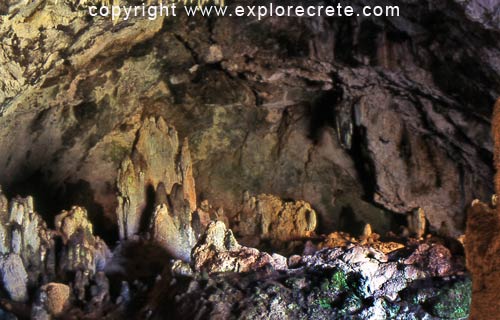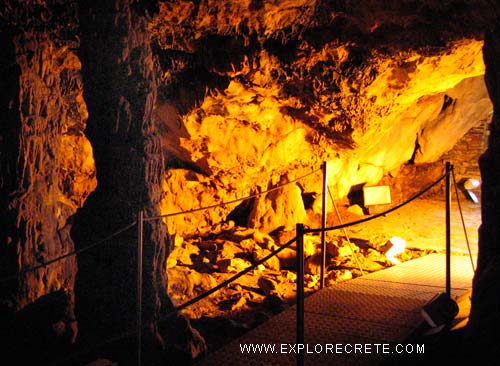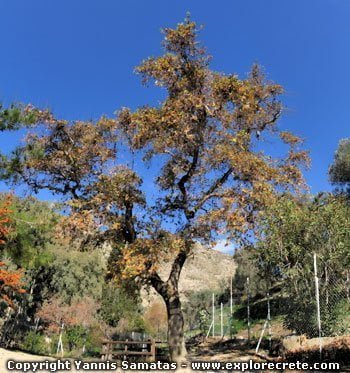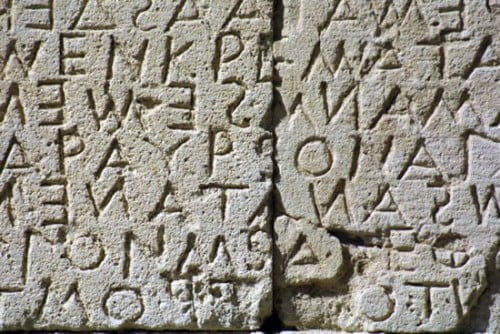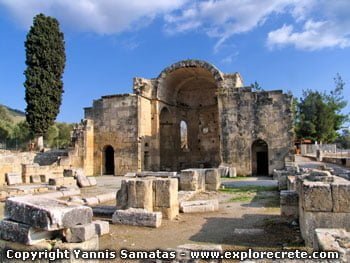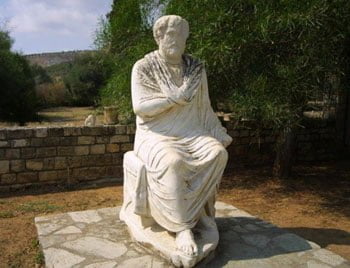Dikteon Cave or Dikteon Andron or Dictaean Cave
The cave of Zeus in Crete
The Dikteon Cave (or Dikteon Andron or Dictaean Cave) is one of the most important and famous of the 3,000 caves in Crete and the 8,500 in Greece.

It is in the impressive Dikteon Cave, rich in stalagmites and stalactites, that Zeus was born according to legend. This is why the Dikteon Cave was already famous in antiquity, dedicated to the worship of the greatest of the gods, as the many offerings found there indicate.
In our days the Dikteon Cave continues to receive many visitors, no longer worshippers, of course, but travellers from all over the world.
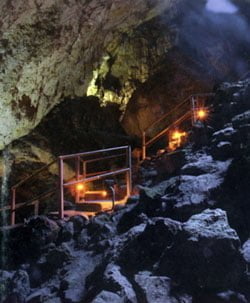
Location of the Dikteon Cave
The Dikteon Cave is found in the Mount Dicte range in East Crete, on the Lassithi Plateau.
The Lassithi Plateau was inhabited as early as the Neolithic Period (6000 BC) and is one of the few sites in the Mediterranean where settlements arose at such high altitude (an average of 840 m. above sea level). An important factor was that the Lassithi Plateau has particularly fertile soil, and large amounts of water from the snow that falls on the peaks of My Dicte collect in the water table.
To visit the Dikteon Cave you need to drive up to the Lassithi Plateau, which is near Neapoli, Malia, Stalida and Hersonissos. It is not many kilometres from these as the crow flies, but the road is winding and uphill, so you will need 45 minutes to an hour to reach the Lassithi Plateau and the village of Psychro.
The Dikteon Cave lies at an altitude of 1025 m. on the northern slopes of Mount Dicte, which dominates the Lassithi Plateau and the whole of East Crete. The cave is near the village of Psychro, which is why it is also known as Psychro Cave.
From Psychro, follow the paved path with oak trees on either side. For the more adventurous, at the beginning of the path you will find donkeys to take you up to the Dikteon Cave. At the end of the short path, just before the cave entrance, it is worth stopping to catch your breath, enjoy the panoramic view of the whole plateau and draw into your lungs the refreshing mountain air, scented with thyme, sage and other local aromatic herbs. It’s a wonderful feeling, making you think it was no accident that the Dikteon Cave was chosen as the site of such an important event as the birth of Zeus, Father of the Gods of Olympus.
Inside the Dikteon Cave
On entering the Dikteon Cave, you find yourself in the antechamber and immediately notice the difference in temperature. The sun’s rays cannot penetrate into the cave and the humidity, as in all caves, can reach 85%, while absolute silence prevails.
These ideal conditions make the Dikteon Cave an important habitat, rich in animal life. In the antechamber roost rock doves and other birds, while deeper in live species from arthropods to the Long-Eared Bat.
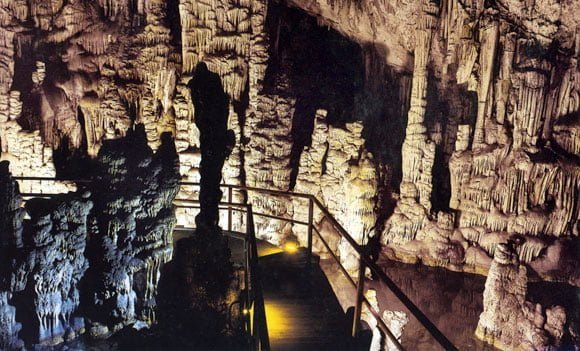
In the antechamber of the Dikteon Cave were discovered the foundations of a built altar and the remains of offerings. The worshippers’ offerings, such as olive oil, honey, wine, wheat and animal sacrifices, were placed on the altar and burnt. The ashes were still considered offerings, so they could not be thrown away like common rubbish; they were collected reverentially next to the altar.
The Dikteon Cave was in continuous use over a long period of time, so due to the lack of space it seems that many finds have been exposed to fire many times, from successive burnings of offerings on the same altar. An unfortunate consequence of the use of the cave down the centuries is that many finds have been despoiled. As you descend into the cave you will see the ancient walls of the temenos, the sacred space.
The Dikteon Cave consists of five chambers large and small. The most impressive sight is the lake at the lowest point, surrounded by massive stalactites and stalagmites.
To reach the lake, suitable shoes are recommended. Remember that the lake is at its lowest level in late September, while in the winter it rises noticeably due to rainfall.
At the lake you will see the “Mantle of Zeus”, a stalactite which hangs over the lake like a chandelier and whose shape, in the local imagination charged with centuries of myths, resembles a cloak.
At the back of the lake you can easily see a small chamber of the Dikteon Cave, in which it is said that the Father of the Gods was born.
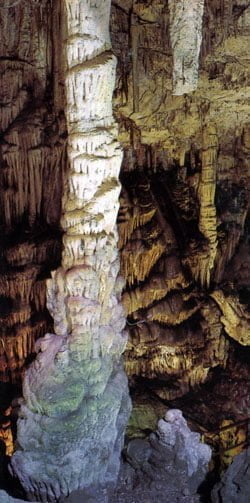
Map of Dikteon or Psychro Cave
This map shows the interior of the Dikteon Cave with its various chambers and the visitors’ route.
The cave is on two levels, the upper (Z), which is not so interesting, and the lower, which is divided into five chambers.
The stalactite known as the “Mantle of Zeus” is in chamber D, while Zeus is supposed to have been born on the spot where the lake is today.
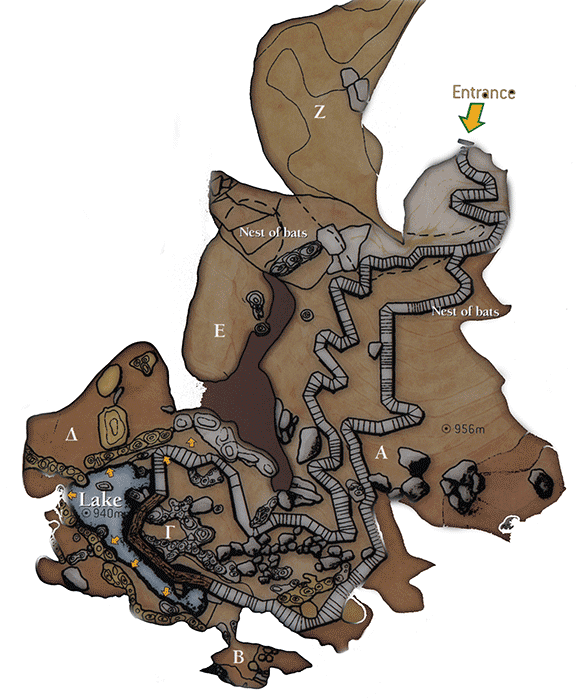
The cult of Zeus at the Dikteon Cave
The sacred Dikteon Cave seems to have been a central sanctuary of East Crete, with two possible annexes at Praisos and Palaikastro. Many myths surround the cave, demonstrating its significance for Crete and indeed the whole of ancient Greece.
The Dikteon Cave and the Ideon Cave in central Crete are the most important ancient sacred caves in Crete, and they share many myths. The most famous myth is obviously the birth of Zeus, which Hesiod tells us took place near the city of Lyktos in east-central Crete, i.e. at the Dikteon Cave.
Examination of the various finds has shown that the Dikteon Cave was used by humans as early as deepest antiquity. Originally it was probably a place of habitation and burial, while from the 2nd millennium to around 700 BC it was used as a place of worship.
The god worshiped in the Dikteon Cave was the Diktaean Zeus. He is depicted on the earliest offerings as a young, beardless man. He died and was reborn each year, in a spectacular way: fire blazed up from the depths of the cave at the moment of his rebirth.
Information on the ritual of the festivals in honour of Zeus comes from a major find, the fragmentary inscription bearing the Hymn to Diktaeann Zeus. As it says, “…Greatest Kouros (Zeus)… you come each year to Dicte and we chant your Hymn… striking lyres… to the sound of pipes… around your altar…”
The Hymn was a prayer by worshippers at the Dikteon Cave for prosperity for their families, flocks, fields and ships, and for peace and justice to prevail.
History of the Dikteon Cave
The archaeological finds to date have shown uninterrupted human presence in the Dikteon Cave from the end of the Neolithic period onwards, i.e. for the last 6,000 years.
It may have been inhabited and used for burials, but it certainly operated as a cult centre from the Minoan to the Archaic Period (2000-700 BC), while worship at the cave continued sporadically until Roman times (1st c. BC-1st c. AD), with periods of flowering and relative decline.
From the 16th century AD to 1883, the Dikteon Cave was used as a shelter by local shepherds and hunters.
The significance of the cave as a major cult cave of antiquity was discovered by chance, as is usually the case, in 1883. In 1886 the Italian archaeologist Federico Halbherr carried out the first, small-scale excavations.
The first systematic excavation, however, began in 1899 under the British archaeologist and Director of the British School of Archaeology at Athens, David Hogarth. The excavation brought to light finds hidden in the Dikteon Cave for centuries, which were older than those of the Ideon Cave: a built altar, offerings placed by worshippers in crevices in the rock, and other ritual artefacts.
© explorecrete.com All Rights Reserved. Reproduction or copying without permission is prohibited.

